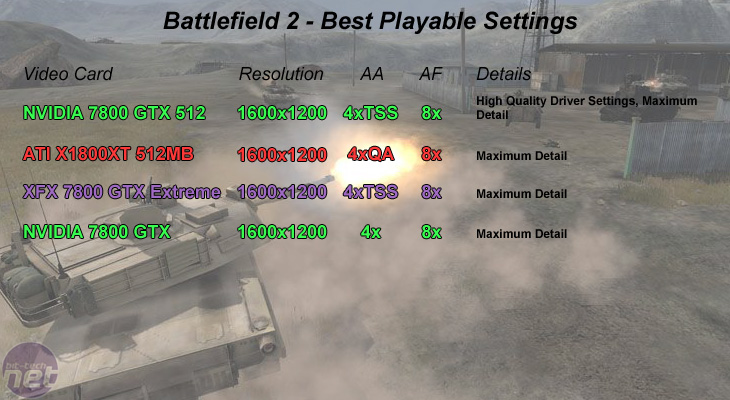
Battlefield 2
Publisher: Electronic ArtsBattlefield 2 features an all-new game engine based on the DirectX 9.0 API. There is no Shader Model 3.0 support, but the majority of hardware will use a Shader Model 2.0++ mode that includes support for Normal Maps, Parallax Mapping, Full-Resolution Dynamic Shadowing, Post Processing and Fog.
The game will look the same on both NVIDIA and ATI hardware, so there is no advantage of choosing one over the other in image quality related circumstances. The only major difference is that Ultra Shadow 2 is utilised on NVIDIA's hardware, while the shadowing on ATI hardware is done using a slightly different technique.
We played three five-minute segments of the same map, reporting the median frame rate. We found that there was no ready way to duplicate testing situations manually in this game, so we felt that taking a typical slice of action from the game was the best way to report our findings. We controlled Anti-Aliasing from inside the game, while Anisotropic Filtering was set to 8xAF when the 'Texture Filtering' option was set to 'High'.
Below is a table of the best-playable settings that we found best for each video card configuration. In this title, we found that 28 to 30 frames per second minimum and a target of 60 frames per second (or higher) for the average frame rate delivered a smooth and fluid gaming experience.

Some people have complained about texture shimmering on NVIDIA hardware in Battlefield 2 - we have noticed it if we move our focus away from playing the game, but we've felt that it was a non-issue issue. However, we were able to completely remove any hint of obvious shimmering with the GeForce 7800 GTX 512MB without us having to lower the in game details. Again, there was so much spare performance left unused on the GeForce 7800 GTX 512MB that it made sense to enable High Quality driver settings and still experience a gaming experience that was unmatched by any of the video cards.
Even ATI's Radeon X1800XT 512MB - which outclasses the two 256MB 7800 GTX's in the smoothness department in this particular title - could not match the gaming experience delivered by the GeForce 7800 GTX 512MB. We experienced an average frame rate of over 70 frames per second, and a minimum of 35 frames per second. That was the only point during our Battlefield 2 gameplay evaulation where the frame rate dropped below 40 frames per second, with the majority of frames being rendered well above 50 fps.
The Radeon X1800XT, by comparison, managed a 69 frames per second average and a minimum of 32 frames per second. Some clock speed increases may help to increase the performance above what we experienced at the video cards default clock speeds, but both the the minimum and average frame rates will need to improve in order to match the GeForce 7800 GTX 512MB.

MSI MPG Velox 100R Chassis Review
October 14 2021 | 15:04






Want to comment? Please log in.